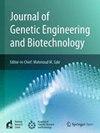中国水杨亚种的遗传分化与保护研究。使用SCoT标记和DNA条形码从Musa Bay提取了桃鼻草
IF 2.8
Q3 Biochemistry, Genetics and Molecular Biology
Journal of Genetic Engineering and Biotechnology
Pub Date : 2025-09-03
DOI:10.1016/j.jgeb.2025.100563
引用次数: 0
摘要
了解遗传多样性对盐生植物物种的保护和管理至关重要,特别是在生态敏感和受工业影响的地区。在本研究中,选取了52份海雀属植物。在Musa Bay的不同微生境中收集了sinus-persica,包括沿海地区、岛屿和石化场地。经过全面的形态学评估,发现表型相似性高,并确保广泛的生态覆盖,选择了16个代表所有主要微生境的材料进行分子分析。利用SCoT标记和DNA条形码(ITS和trnH-psbA区)对其遗传结构进行了研究。SCoT标记显示出相当大的多态性和部分遗传分化,特别是在石化和天然盐碱生境中。ITS测序鉴定出5个单倍型,但没有形成单系分支,表明浅分化和可能的祖先多态性。相比之下,在trnH-psbA质体区未检测到变异。这些结果是全球首次报道该亚种的ITS和trnH-psbA单倍型。虽然由于样本量和标记覆盖率有限,这些发现是初步的,但它们为使用高分辨率基因组工具的未来研究提供了关键的基线。我们的研究结果强调了生境破碎化和人为压力对遗传模式的影响,并强调了在生态脆弱的生境中保护遗传独特的物种对支持这种沿海盐生植物的长期生存和可持续利用的重要性。本文章由计算机程序翻译,如有差异,请以英文原文为准。
Genetic differentiation and conservation insights into Salicornia iranica subsp. sinus-persica from Musa Bay using SCoT markers and DNA barcodes
Understanding genetic diversity is essential for the conservation and management of halophyte species, especially in ecologically sensitive and industrially impacted regions. In this study, 52 accessions of Salicornia iranica subsp. sinus-persica were collected from diverse microhabitats across Musa Bay, including coastal zones, islands, and petrochemical sites. Following comprehensive morphological assessments showing high phenotypic similarity, and to ensure broad ecological coverage, 16 accessions representing all major microhabitats were selected for molecular analysis. SCoT markers and DNA barcoding (ITS and trnH-psbA regions) were employed to investigate their genetic structure. The SCoT markers revealed considerable polymorphism and partial genetic differentiation, especially between accessions from petrochemical and natural saline habitats. ITS sequencing identified five haplotypes without forming a monophyletic clade, indicating shallow divergence and possible ancestral polymorphism. In contrast, no variation was detected in the plastid region trnH-psbA. These results represent the first global report of ITS and trnH-psbA haplotypes for this subspecies. While the findings are preliminary due to limited sample size and marker coverage, they provide a critical baseline for future studies employing high-resolution genomic tools. Our findings underscore the influence of habitat fragmentation and anthropogenic pressures on genetic patterns and emphasize the importance of conserving genetically distinct accessions in ecologically vulnerable habitats to support the long-term survival and sustainable utilization of this coastal halophyte.
求助全文
通过发布文献求助,成功后即可免费获取论文全文。
去求助
来源期刊

Journal of Genetic Engineering and Biotechnology
Biochemistry, Genetics and Molecular Biology-Biotechnology
CiteScore
5.70
自引率
5.70%
发文量
159
审稿时长
16 weeks
期刊介绍:
Journal of genetic engineering and biotechnology is devoted to rapid publication of full-length research papers that leads to significant contribution in advancing knowledge in genetic engineering and biotechnology and provide novel perspectives in this research area. JGEB includes all major themes related to genetic engineering and recombinant DNA. The area of interest of JGEB includes but not restricted to: •Plant genetics •Animal genetics •Bacterial enzymes •Agricultural Biotechnology, •Biochemistry, •Biophysics, •Bioinformatics, •Environmental Biotechnology, •Industrial Biotechnology, •Microbial biotechnology, •Medical Biotechnology, •Bioenergy, Biosafety, •Biosecurity, •Bioethics, •GMOS, •Genomic, •Proteomic JGEB accepts
 求助内容:
求助内容: 应助结果提醒方式:
应助结果提醒方式:


